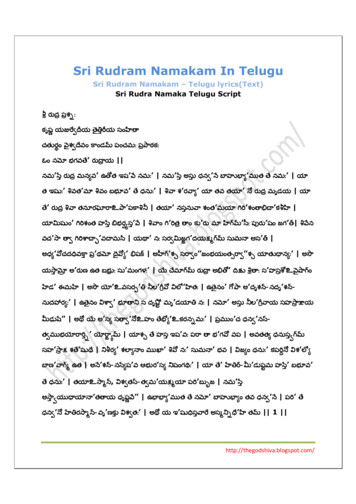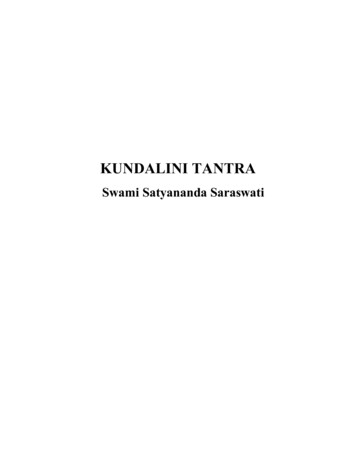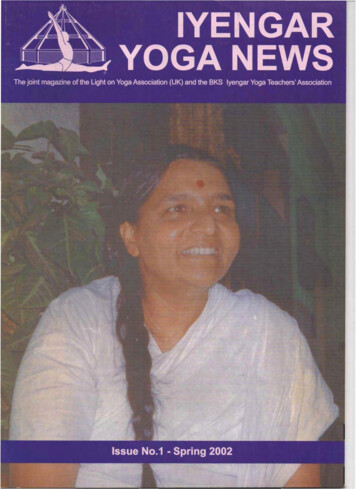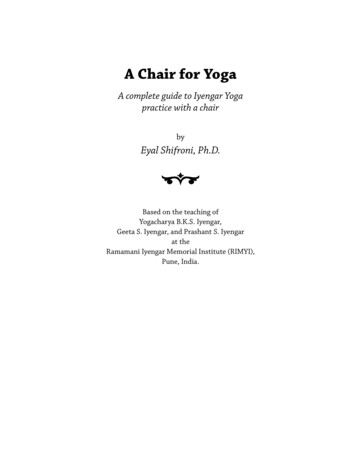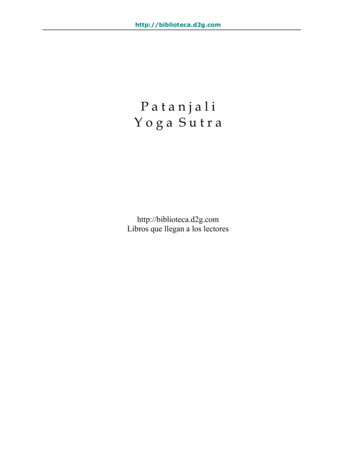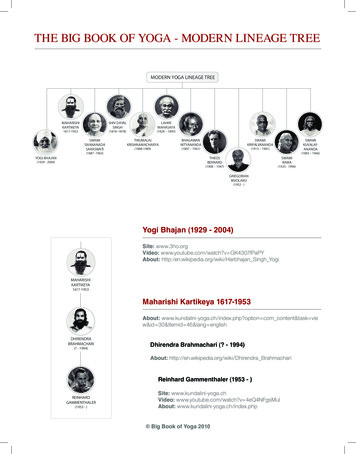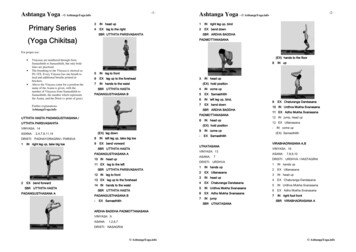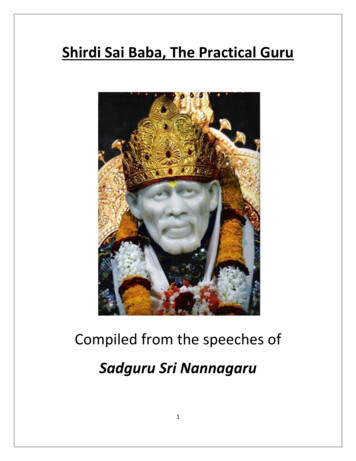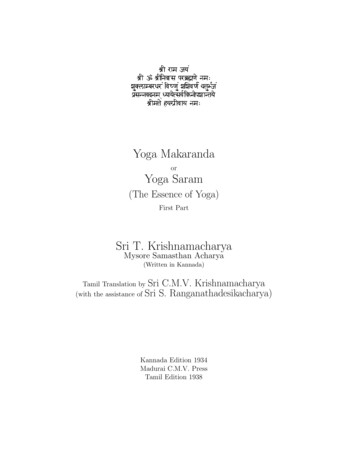
Transcription
Yoga MakarandaorYoga Saram(The Essence of Yoga)First PartSri T. KrishnamacharyaMysore Samasthan Acharya(Written in Kannada)Tamil Translation by Sri C.M.V. Krishnamacharya(with the assistance of Sri S. Ranganathadesikacharya)Kannada Edition 1934Madurai C.M.V. PressTamil Edition 1938
Translators’ NoteThis is a translation of the Tamil Edition of Sri T. Krishnamacharya’s YogaMakaranda. Every attempt has been made to correctly render the content andstyle of the original. Any errors detected should be attributed to the translators.A few formatting changes have been made in order to facilitate the ease of reading.A list of asanas and a partial glossary of terms left untranslated has been includedat the end.We would like to thank our teacher Sri T. K. V. Desikachar who has had aninestimable influence upon our study of yoga. We are especially grateful to RoopaHari and T.M. Mukundan for their assistance in the translation, their carefulediting, and valuable suggestions. We would like to thank Saravanakumar (ofECOTONE) for his work reproducing and restoring the original pictures. Severalother people contributed to this project and we are grateful for their efforts.There are no words sufficient to describe the greatness of Sri T. Krishnamacharya. We began this endeavour in order to better understand his teachingsand feel blessed to have had this opportunity to study his words. We hope thatwhoever happens upon this book can find the same inspiration that we havedrawn from it.Lakshmi RanganathanNandini RanganathanOctober 15, 2006iii
ContentsPreface and Bibliographyvii1 Introduction1.1 Why should Yogabhyasa be done . . . .1.2 Cakras . . . . . . . . . . . . . . . . . . .1.3 Pratyahara . . . . . . . . . . . . . . . .1.4 Dharana and Dhyana . . . . . . . . . . .1.5 Who has the Authority to practise 3452 Investigations of the Yoganga2.1 Yama and Niyama . . . . .2.2 Announcement . . . . . . .2.3 Warning . . . . . . . . . . .2.4 Important Observations . .3 Chapter on Yogabhyasa3.1 Places to practise Yoga . . . . . . . . . . . . . . . . . . .3.2 Discussion of when to begin Yogabhyasa . . . . . . . . .3.3 Dietary Restrictions for the Yogabhyasi . . . . . . . . . .3.3.1 Food that can be eaten . . . . . . . . . . . . . . .3.3.2 Food that should be avoided . . . . . . . . . . . .3.4 Section on recommended activities and activities to avoid3.4.1 Activities to avoid . . . . . . . . . . . . . . . . .3.4.2 Activities that should be done . . . . . . . . . . .3.5 Section on Nadis . . . . . . . . . . . . . . . . . . . . . .3.6 Section on the investigation of Shatkriyas . . . . . . . . .3.7 Section on Vayu . . . . . . . . . . . . . . . . . . . . . . .3.8 Section on the investigation of the twenty Mudras . . . .v.
4 Chapter on Asana51Index of asanas . . . . . . . . . . . . . . . . . . . . . . . . . . . . . . . 152List of Figures154Glossary of Terms159vi
Sri Hayagrivaya NamahaThe Lord of the auspicious Karnataka throne, one who shines with many titlessuch as auspicious king etc., one who rules us with unbounded and extraordinaryaffection and love without any expectation, the Lord and Emperor, the fourth SriKrishna Rajendra with his sacred command — in order to serve him eternally, Ihumbly offer this work.This text contains the essential concepts from many texts of antiquity listedbelow.I have studied the texts listed below under the blessing of a great teacher andhave explained the truths contained in them that I have personally experienced.I request that the Lord of the auspicious Karnataka throne, the great Lordand Emperor, the fourth Sri Krishna Rajendra, accept this work and allow myhumble self to fulfil my endeavor and bless me.More than this, I have nothing to say in this preface.Bibliography1. Rajayoga Ratnakaram2. Hathayoga Pradipika3. Yoga Saravalli4. Yoga Balaprathipikai5. Ravana Nadi (Nadi Pariksa of Ravana)6. Bhairava Kalpam7. Sri Tattvanidhi8. Yoga Ratnakarandam9. Mano Narayaneeyam10. Rudrayameelam (Rudrayamalam)11. Brahmayameelam12. Atharvana Rahasyamvii
13. Patanjala Yogadarshanam14. Kapilasutram15. Yogayajnavalkyam16. Gheranda Samhita17. Narada Pancharatra Samhita18. Satvata Samhita19. Siva Samhita20. Dhyana Bindu Upanishad21. Chandilya Upanishad22. Yoga Shika Upanishad23. Yoga Kundalya Upanishad24. Ahir Buddhniya Samhita25. Nada Bindu Upanishad26. Amrita Bindu Upanishad27. Garbha UpanishadYear of Bhavathe Month of Aipasi, Wednesday, Swati10-10-1934viiiIn the service of the fourthLord and Emperor Krishna RajendraT. KrishnamacharyaMysore
Chapter 1Introduction1.1Why should Yogabhyasa be doneWhy should yoga abhyasa be done? What does one gain as a result of practisingyoga? What should the duration of the practice be (how much time should bespent on the practice)? What are the reasons for and effects of the practice?People keep asking me these questions. Others ask me various questions relatedto this subject. I have written this book in order to answer their questions.But before doing that I would like to say a few words. Nowadays, the attitudesof people in our society are changing. They look at all their affairs as businessventures and think only in terms of making a profit or loss. This outlook is onthe increase. This attitude is becoming an obstacle to our spiritual progress. Itis pathetic and sad that this instant gross business-oriented attitude meant tobe applied during transactions with a road-side vendor has been applied to evenmatters involving sanatana dharma and spiritual truths.One cannot have such a trivial attitude as expecting immediate benefits inauspicious matters like yogabhyasa, worship, sandhya vandanam (salutation tothe sun) or chanting of mantras as though one were a labourer who does onehour of work and expects immediate payment. They should not lament thatthey have not received even one paisa for all the time spent on this. When thispattern of thinking begins, we enter a phase of deterioration day by day.Auspicious matters such as yogabhyasa are not like business ventures conducted at a road-side shop. The readers should note this point carefully. Theyshould reflect on how much we get paid for all the time that we waste every day.For example, how much time have we wasted on sleep or useless chatter or othersuch activities? All living beings including humans spend a minimum of 6 to1
2CHAPTER 1. INTRODUCTIONFigure 1.1: Yogasala
Figure 1.2: Yogabhyasis at the Yogasala1.1. WHY SHOULD YOGABHYASA BE DONE3
CHAPTER 1. INTRODUCTION4Figure 1.3: Students at the Yogasala
Figure 1.4: Students at the Yogasala1.1. WHY SHOULD YOGABHYASA BE DONE5
6CHAPTER 1. INTRODUCTION7 hours on sleep. Does anybody think that they have wasted too many hourson this pointless or unprofitable sleep and decide that henceforth they will notsleep? Never. The reason is that if this time is not spent daily on sleep withoutexpectations of remuneration, the body will perish. Maybe one can forego five tosix days of sleep. Even this causes the head to start reeling. After that, one hasno energy to do anything. Therefore, everybody knows with certainty and fromexperience that all living beings need a specified amount of sleep irrespective ofwhether they obtain any material benefit from it. Physical health, enthusiasmand liveliness are all benefits of sleep. Not only that, it is not an exaggeration tosay that our body and mind are rejuvenated as a result of sleep.How does sleep acquire this power of rendering so many benefits? Where didthis come from? Why is it that without sufficient sleep living beings becomedull in their mind, the body heats up, and they develop a dullness of intellect, alack of enthusiasm, and weakness? It is important to first explain this aspect indetail to readers. The answers to this will clear many doubts the readers have.Through these explanations, the earlier questions will also be answered properly.When the activities of the mind stop, one can sleep well. Otherwise, therewill be no sleep. Nobody has ever had the experience of having the mind besimultaneously active in one part and asleep in another. When all movementsof the mind reduce, when thoughts such as “I”, “mine”, “my greatness”, cease,and when all the affairs of the mind stop, only then is proper sleep possible.Only such a sleep gives a sense of well-being to the body and mind. If evensome minute thought or mental activity persists, the sleep will be mixed withdreams. Such a sleep (with dreams) will not contribute towards the well-beingof the body or mind. Everybody knows that such a proper sleep occurs onlywhen the mind remains still in a single state and various mental activities likeaction-oriented thoughts, fluctuations of thought, dream, and imagination cease.When such activities of the mind cease, good sleep becomes possible. Hence sleepis a complete cessation of all activities of mind. From this we realize that all thebenefits we gain as a result of sleep are due to the quietude of the mind. Whenthe thoughts and the mind wander here and there, there will be no sleep. Thisleads one to feel as though one is going mad.In the jagrata avastha, the mind wanders here and there. Due to this, everyliving being gets involved in every activity that it encounters, the mind remains instates of sorrow and pleasure and as a consequence becomes weary and exhausted.As a result, once in awhile, the mind tries to escape and go away in order to seekrest, somehow tries to find peace and a remedy for exertion, and tries to sleep.We all know that such sleep (following exhaustion) will definitely rejuvenate the
1.1. WHY SHOULD YOGABHYASA BE DONE7mind and remove the tiredness. Therefore there is no doubt that a deep sleepwill be able to remove any weariness faced by the mind. What this teaches usis that only when there is no agitation or confusion of the mind, good qualitieslike enthusiasm, good health, knowledge, sharp memory, agility, contentment andaffection towards others will develop in a person. Instead of that, if the mindgets disturbed, negative qualities like tiredness, lack of enthusiasm and lazinesswill arise and lead a person to sorrow. This is why every lifeform goes to sleepevery day and gets refreshed. This also expels physical exhaustion and tiredness.Moreover, it can be stated clearly that one who has not had proper sleep for sometime is closer to death. All activities of the mind must cease if one is to sleepproperly.Now let us look into the questions discussed earlier.The philosophy of yoga is to withdraw the mind from external activities, todraw its focus inwards, and to bring it into deep concentration. The benefit ofsuch a process has been explained above using the example of sleep. The resolution of mind acquired from sleep is of a tamasic nature. But the quality of mind(concentration, strength) acquired from yoga sadhana is of a pure sattva guna.That is the difference between the two. It goes without saying that the mental strength acquired through a base of sattva guna is superior to that acquiredthrough a base of tamasic nature. Whatever health, strength and happiness isacquired through normal sleep is exceeded more than 1000 times over by thestrength, health and happiness acquired from the mental strength one developsthrough the practice of yoga. Ordinary people will not understand this. Themental concentration and strength acquired through yogabhyasa is called yoganidra and ordinary mental resting which is tamasic in nature and is acquired asa result of physical exhaustion is called ordinary nidra.After all the activities and movements of the mind cease, the mind which hasbecome predominantly sattvic in nature becomes steady. Until it develops thissteadiness, we do not obtain any benefits from it. Until the mind is made toremain steady, all the time spent on this pursuit will be wasted and we will notreceive any benefits from actions performed by a shaky mind. As a result, somemight ask, if spending time on yoga might not initially produce any benefit thenwhy should one practise it? This question seems justified, but it must be saidthat such questions are asked only by those who have not thought deeply aboutthe subject. “No accomplishment or achievement is possible without effort” is agreat saying. Normally, if a man in search of profits ventures into the relevantactivity without following the proper guidelines and asks “What can be gainedas a result of this? Who knows whether I will or will not gain anything” and
8CHAPTER 1. INTRODUCTIONis quite doubtful about achieving positive results, he will not achieve anything.But if he makes the effort to practise by following the correct path, he will notbe deprived of the fruits of his practice. For example, let us take the fields ofeducation and agriculture. Just as one reaps the benefits in these fields only aftera period of time, so it is in the case of yogabhyasa practised with krama (followingthe regular order). Only after practising according to krama for a period of timewill the yogabhyasi gain strength of body, good health and happiness, and themind will mainly reside in sattvaguna. One more example — consider the caseof a mango tree. Let us assume that there are plenty of fruits in it. Let us alsoassume that the owners of the tree have given us permission to pluck and eat thefruits. Yet with all this, if we did not move from our present place, or even if wedid move, supposing we didn’t go to the location of the mango tree, or supposingthat we did go but did not make an effort to climb it, or supposing that wedid climb the tree, but did not reach out to pluck the mango, or supposing thatwe did reach out, but that we did not bother to pluck the fruit, or even if weplucked the fruit, if we did not bother to tast
Tamil Translation bySri C.M.V. Krishnamacharya. (with the assistance ofSri S. Ranganathadesikacharya) Kannada Edition 1934 Madurai C.M.V. Press Tamil Edition 1938. Translators’ Note. This is a translation of the Tamil Edition of Sri T. Krishnamacharya’sYoga Makaranda. Every attempt has been made to correctly render the content and style of the .

